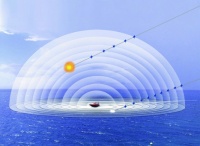
Developed by UK technology group Cambridge Consultants, the system will be used in naval applications to measure the trajectory of missiles as they approach a target at a range of up to 1,000ft (305m).
According to the company, this is the first time holographic radar technology will be used alongside a target scoring system in this way.
Gary Kemp, programme director at Cambridge Consultants, said: ’One of the navy’s principle exercises is when a fast-attack boat is coming towards a ship and needs to be shot down. By installing the radar system on the attack boat, we can accurately measure the trajectory of each shooting round as it flies towards the target.’
The data from the radar system is transmitted in real time through a telemetry link from the target vehicle to a ground station. The system can continuously monitor a large volume of space and therefore provides more detail than existing radar technologies, which rely on a rotating beam that can only focus on a specific area at any one time.
’The real advantage of this system… is its ability to fundamentally reject clutter targets’, added Kemp. ’What the holographic system allows you to do is to detect everything you see, including all of the clutter, and extract the signals you are interested in by using powerful signal processing.’
Cambridge Consultants has already proven the ability of the holographic radar when mounted on a land vehicle. It is now scaling up the technology for use on a larger sea target and will begin proof-of-concept firing trials at the end of this year.
Kemp said: ’One thing that will always work in our favour is Moore’s Law. As more and more powerful signal processes become available, the potential of our radar will grow with that. Beyond this application, we could be looking at a whole range of uses for holographic radar, including airborne collision avoidance techniques and improved accuracy in blind landing systems.’




Poll: Should the UK’s railways be renationalised?
I'm reminded of the old adage about stupidity is doing the same thing time and time again, expecting different results. The current model simply...